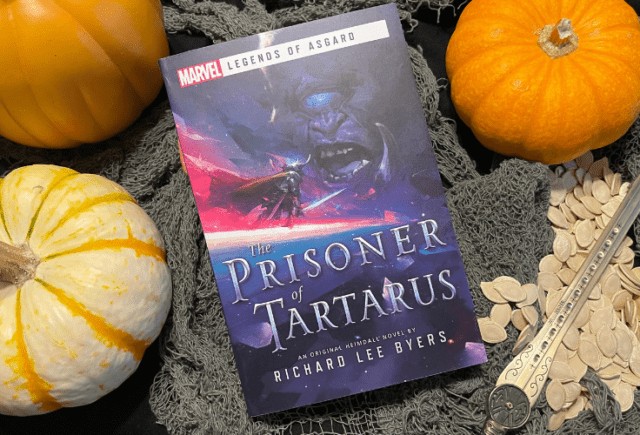Book Review: ‘The Prisoner of Tartarus: A Marvel Legends of Asgard Novel’ By Richard Lee Byers

In The Prisoner of Tartarus, Richard Lee Byers gives us an origin story we didn’t know we needed. But we did! Byers shares with us not just the story of Heimdall coming into his own, but also the story of how the Bifrost, one of the most important means of transportation in the Marvel universe, came to be.
[Note: While I am reviewing this novel independently and honestly, it should be noted that it has been provided to me by Aconyte for the purpose of this review. Warning: My review of The Prisoner of Tartarus contains some spoilers!]
The Creation of the Bifrost
So it turns out (obviously in retrospect) that the Bifrost didn’t always exist and was created at some point. An Asgardian sorcerer, Ulbrecht, came up with the idea as a means to travel directly between worlds without a treacherous journey on Yggdrasil. He then figured out how to create the bridge but the job was too big for any one person. So he takes his concept to Odin, who approves and tasks various mages and the Blackhammer dwarves, under Ulbret’s supervision, with creating the Rainbow Bridge.
A large camp is set up on Midgard (Earth) due to various vague magical necessities. In addition to all the dwarves, mages, sorcerers, and camp workers, a set of warriors are sent to protect the site. Their main objective is to make sure that no mortals wander onto the site and it seems like an easy assignment. Heimdall, who’s had some problems with authority in the past but is still one of the best warriors in Asgard, is sent to oversee the camp.
Eventually, the activity draws the attention of the “stranger gods”. Although their official pantheon is never named, it’s a bit obvious who Pluto and Hephaestus are and where they come from to the readers. But they remain unknown values to Heimdall and that’s the important thing. These stranger gods are afraid that the Asgardians are trying to usurp their followers so Odin and their head god (unnamed in the book) come to an agreement that some of the stranger gods can observe the magical workings to confirm the Asgardians are doing what they say they’re doing.
Detective Heimdall investigates a death
Of course, the creation of the Bifrost doesn’t go smoothly. Things seem to be going well, even with the arrival and interference of the stranger gods. Then one of the cyclops that came with Hephaestus was found dead in his tent. It’s determined that he was murdered and a culprit, a Blackhammer dwarf named Kamorr, is quickly found. But Heimdall isn’t convinced of the facts of the case. Something seems off and he insists on more investigation before Kamorr is convicted. Kamorr is so grateful for Heimdall’s treatment of him that he becomes his personal assistant.

The cyclops’ death sets off Heimdall’s intuition. He knows something isn’t right and he wants to question the ghost of the cyclops. After receiving a run-around from Pluto, Heimdall decides to follow him to the land of the dead for his pantheon (Pluto is the god of the dead and returns there often to check on his domain).
Kamorr insists upon coming with Heimdall for backup and off they go. Heimdall manages to sneak into the land of the dead and find the cyclops but he learns more than he expected to. This is much bigger than one murdered cyclops. Unfortunately, he’s caught and his memory is erased. Very erased, he doesn’t even remember his name, let alone why he’s in Tartarus or where he should actually be. Luckily for everyone Kamorr was able to hide and stay uncaptured. He bides his time until the right moment, then strikes and frees Heimdall.
Tartarus Trouble
Although Heimdall is free, the two are still stuck in Tartarus with no means to escape. Worse, Heimdall still has none of his memories. Kamorr tries to remind him of the great warrior and strategist he is but to no avail. Without his memories, Heimdall has no confidence. Despite what Kamorr tells him about himself he doesn’t believe that he can really do any of the things this “Heimdall” does.
Meanwhile, back at camp, Uschi the Valkyrie has been left in charge. She is doing the best she can to hold down camp until Heimdall returns (she actually does great under the circumstances), but someone is causing all kinds of mayhem. There are magical assaults, cave-ins, and raids from other realms. What started as a peaceful project has gone to pieces rather fast. Could someone be trying to make diversions and keep everyone off-balance? If so, why?
A buddy adventure ensues in The Prisoner of Tartarus
Heimdall may have had his memory erased but Kamorr has not. He knows exactly what is going on and how very important it is to get back to camp. He also knows they have a time limit. They have to get back before the Bifrost is activated or things will be very bad. Kamorr also knows that Heimdall without his memories is not very helpful.

He decides to relate the entire story of the past few days to Heimdall during their trip across Tartarus in an attempt to jog Heimdall’s memory. It is a very different way of presenting a story. There were interesting bits of irony as the reader (and Kamorr) knew things that affected the story Kamorr was telling. Thankfully there were still plenty of surprises for the readers so the telling didn’t feel like a boring recap with the big reveals already known.
The whole relationship between Heimdall and Kamorr was uplifting. Kamorr nearly hero-worships Heimdall, yet he clearly sees his faults and isn’t afraid to call him out if the need arises. On the other hand, Heimdall sees Kamorr as much more skilled and capable than Kamorr sees himself. Together they lift each other up to become better and stronger than they could be on their own.
Honestly, watching Heimdall come back to himself as he gains confidence is nice, but watching Kamorr come to see himself through Heimdall’s eyes is even better. Through the course of the trip, Kamorr comes to see that he may have been an outcast at home, but that doesn’t make him worthless. He finds self-worth and his growth is my favorite part of the story.
Missing Links
It was really interesting to see the backstory to the creation of the Bifrost. The Rainbow Bridge is something that is used all the time in Marvel but isn’t really thought that much about. It was also interesting to see Heimdall before he was the perfect sentry of the Bifrost that we are used to seeing.
I would like to mention that The Prisoner of Tartarus is the third in the Heimdall series. To trace the entirety of Heimdall’s ascent from simple soldier to the guardian of the Rainbow Bridge, you have to read The Head of Mimir and The Rebels of Vanaheim. Luckily, while these stories are no doubt fascinating and deserve a read, they are not necessary to enjoy The Prisoner of Tartarus. Byers’ story is well-crafted enough that it can be thoroughly enjoyed without the additional background. I recommend it to anyone looking for a good read, especially if Asgard is of special interest to you.
My Rating: 9/10
The Prisoner of Tartarus: A Marvel Legends of Asgard Novel by Richard Lee Byers is available now from Aconyte Books. Have you read the novel? What are your thoughts on it? Let us know on social media. If you haven’t already, check out my other Legends of Asgard review, Three Swords!
Book Review: Three Swords: A Legends of Asgard Novel by C.L. Werner



